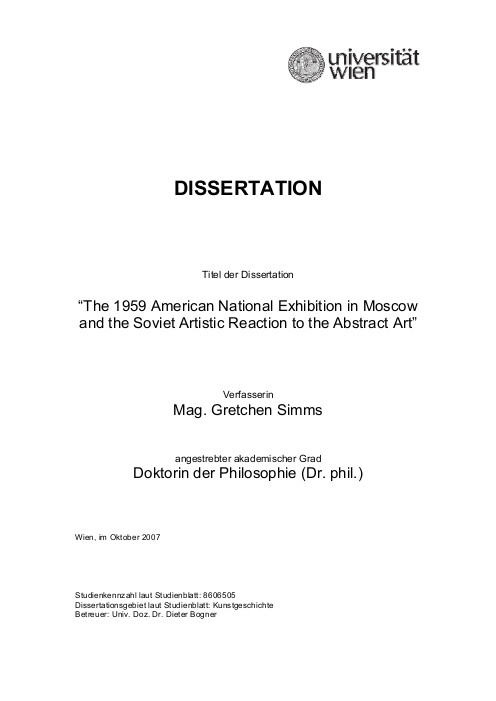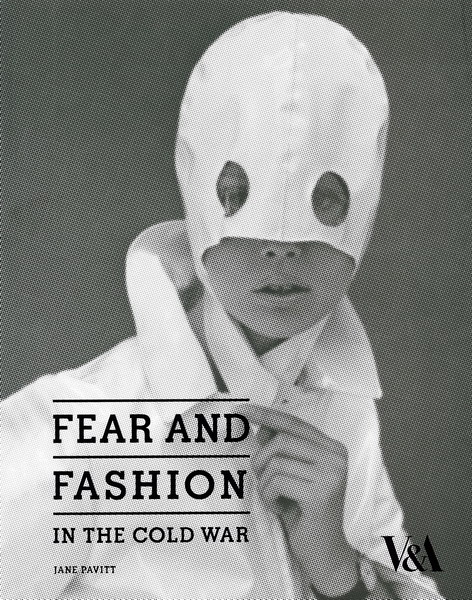Gretchen Simms: The 1959 American National Exhibition in Moscow and the Soviet Artistic Reaction to the Abstract Art (2007)
Filed under thesis | Tags: · abstract art, abstract expressionism, art history, cold war, cultural politics, politics, soviet union, united states

“The American National Exhibition was an exchange exhibition organised by the United States Information Agency (USIA) and took place at Sokolniki Grounds in Moscow in 1959. The overall director George V. Allen and the Association of Federated Artists (AFA) Vice President Lloyd Goodrich, who was also President of the Whitney Museum of American Art in New York, were responsible for the art section of the Exhibition. The art committee selected, intended to show the Soviet public the developments in modern American art since World War I.
The Soviet response to the Exhibition can only be fully appreciated by looking back at the developments within Russian and Soviet art as well as the political and social changes which the peoples in the Soviet Union experienced under Khrushchev. Through the analysis of the Soviet reception of the Exhibition, this dissertation shows how the Soviet public and especially the artworld in Moscow perceived specifically the American abstract art.
It reveals how the American abstract art displayed at the Exhibition facilitated the Soviet artists path in looking back at their Russian roots, looking within themselves and looking outside of their immediate boundaries in order to create new Soviet art.” (from the Abstract)
Art History, University of Vienna
Supervisor Dieter Bogner
191 pages
Paul Betts: The Authority of Everyday Objects: A Cultural History of West German Industrial Design (2004)
Filed under book | Tags: · aesthetics, bauhaus, cold war, design, germany, industrial design, weimar republic

From the Werkbund to the Bauhaus to Braun, from furniture to automobiles to consumer appliances, twentieth-century industrial design is closely associated with Germany. In this pathbreaking study, Paul Betts brings to light the crucial role that design played in building a progressive West German industrial culture atop the charred remains of the past. The Authority of Everyday Objects details how the postwar period gave rise to a new design culture comprising a sprawling network of diverse interest groups—including the state and industry, architects and designers, consumer groups and museums, as well as publicists and women’s organizations—who all identified industrial design as a vital means of economic recovery, social reform, and even moral regeneration. These cultural battles took on heightened importance precisely because the stakes were nothing less than the very shape and significance of West German domestic modernity. Betts tells the rich and far-reaching story of how and why commodity aesthetics became a focal point for fashioning a certain West German cultural identity. This book is situated at the very crossroads of German industry and aesthetics, Cold War politics and international modernism, institutional life and visual culture.
Publisher University of California Press, 2004
Weimar and Now: German Cultural Criticism Series
ISBN 0520240049, 9780520240049
348 pages
Jane Pavitt: Fear and Fashion in the Cold War (2008)
Filed under book | Tags: · 1940s, 1950s, 1960s, cold war, cybernetics, fashion, military, politics

From Barbarella’s bikini to vinyl radiation suits to high-tech jewelry, the Cold War’s impact on fashion was unmistakable.
Atomic anxieties, the space race, technological developments, and the first forays into “super-reality” led to innovations in materials, the cybernetic visions of the 1960s, and a range of surprising responses from artists, filmmakers, scientists, and designers. With a stunning selection of images, including photographs by fashion luminaries such as John French, Fear and Fashion in the Cold War explores how the image of the body was shaped by Cold War concerns between 1945 and 1970. In this engaging book, Jane Pavitt incorporates military, political, and scientific research in an engrossing discussion of how countercultural theories and experiences in the later 1960s shaped an alternative view of the “Cold War Body.”
Publisher V&A, London, 2008
ISBN 1851775447, 9781851775446
128 pages
via Royal College of Art

